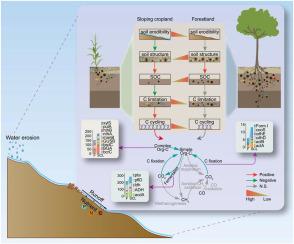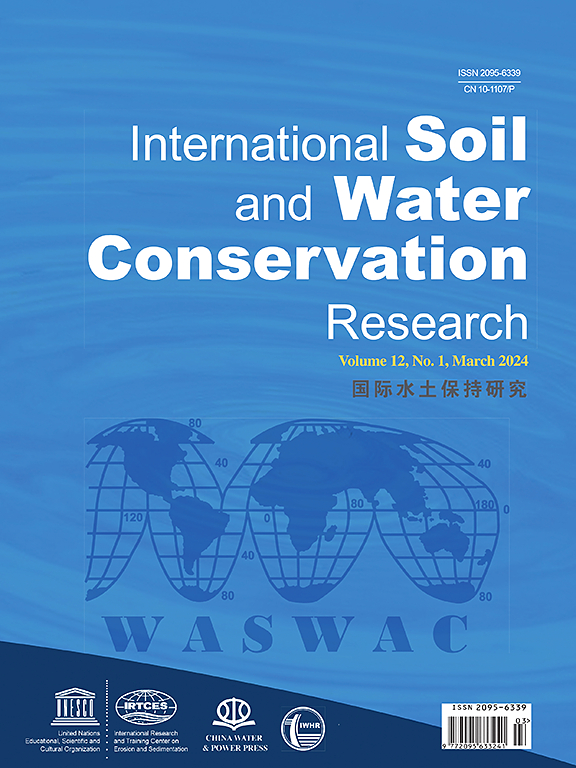Soil erosion accelerates carbon cycling as a response to carbon limitation in erosion-prone sloping cropland
IF 7.3
1区 农林科学
Q1 ENVIRONMENTAL SCIENCES
International Soil and Water Conservation Research
Pub Date : 2025-05-14
DOI:10.1016/j.iswcr.2025.05.004
引用次数: 0
Abstract
Soil erosion accelerates the loss of soil carbon (C) pools and then exacerbates the microbial C limitation. However, the extent to which soil microbial C limitation influences soil C cycling processes in different erosion environments remains unclear. We analyzed the differences in soil organic carbon (SOC) content, extracellular enzyme activities and C limitation between sloping cropland and adjacent forestland in a typical small watershed, and further explored the relationship between soil C limitation and the abundance of C cycling genes in different erosion environments. The results revealed that sloping cropland exhibited a 31.70 % higher soil erodibility (Kerosion) compared to forestland, making it more prone to soil erosion. Moreover, the SOC content in sloping cropland was 61.72 % lower than that in forestland. Although there was no significant difference in absolute enzyme activities between sloping cropland and forestland, the specific enzyme activities per unit of SOC (including carbon, nitrogen and phosphorus enzymes) in sloping cropland were significantly higher than those in forestland. The loss of SOC further exacerbated C limitation in sloping cropland and stimulated an increase in the abundance of C cycle genes involved in complex organic C degradation. Additionally, the C cycling genes enriched in sloping cropland demonstrated a significant positive correlation with soil CO2 emissions (p < 0.01). Therefore, we emphasize that soil erosion stimulates an increase in the abundance of C cycle genes, particularly those involved in complex SOC degradation, as a response to C limitation in erosion-prone sloping cropland. The findings provide scientific support for developing effective soil and water conservation measures to reduce soil C loss and maintain the ecological balance of sloping cropland.

土壤侵蚀加速了碳循环,作为对易侵蚀坡耕地碳限制的响应
土壤侵蚀加速了土壤碳(C)库的流失,进而加剧了微生物碳的限制。然而,不同侵蚀环境下土壤微生物C限制对土壤C循环过程的影响程度尚不清楚。分析了典型小流域坡耕地与邻接林地土壤有机碳含量、胞外酶活性和碳限制的差异,并进一步探讨了不同侵蚀环境下土壤碳限制与碳循环基因丰度的关系。结果表明,坡耕地土壤可蚀性比林地高31.70%,更容易发生土壤侵蚀。坡耕地土壤有机碳含量比林地低61.72%。坡耕地与林地的绝对酶活性差异不显著,但单位有机碳(包括碳、氮、磷酶)的比酶活性显著高于林地。土壤有机碳的流失进一步加剧了坡耕地对碳的限制,并刺激了参与复杂有机碳降解的碳循环基因丰度的增加。坡耕地碳循环基因与土壤CO2排放呈显著正相关(p < 0.01)。因此,我们强调,土壤侵蚀刺激碳循环基因丰度的增加,特别是那些参与复杂有机碳降解的基因,作为对易侵蚀坡耕地碳限制的响应。研究结果为制定有效的水土保持措施减少坡耕地土壤碳流失,维护坡耕地生态平衡提供了科学依据。
本文章由计算机程序翻译,如有差异,请以英文原文为准。
求助全文
约1分钟内获得全文
求助全文
来源期刊

International Soil and Water Conservation Research
Agricultural and Biological Sciences-Agronomy and Crop Science
CiteScore
12.00
自引率
3.10%
发文量
171
审稿时长
49 days
期刊介绍:
The International Soil and Water Conservation Research (ISWCR), the official journal of World Association of Soil and Water Conservation (WASWAC) http://www.waswac.org, is a multidisciplinary journal of soil and water conservation research, practice, policy, and perspectives. It aims to disseminate new knowledge and promote the practice of soil and water conservation.
The scope of International Soil and Water Conservation Research includes research, strategies, and technologies for prediction, prevention, and protection of soil and water resources. It deals with identification, characterization, and modeling; dynamic monitoring and evaluation; assessment and management of conservation practice and creation and implementation of quality standards.
Examples of appropriate topical areas include (but are not limited to):
• Conservation models, tools, and technologies
• Conservation agricultural
• Soil health resources, indicators, assessment, and management
• Land degradation
• Sustainable development
• Soil erosion and its control
• Soil erosion processes
• Water resources assessment and management
• Watershed management
• Soil erosion models
• Literature review on topics related soil and water conservation research
 求助内容:
求助内容: 应助结果提醒方式:
应助结果提醒方式:


